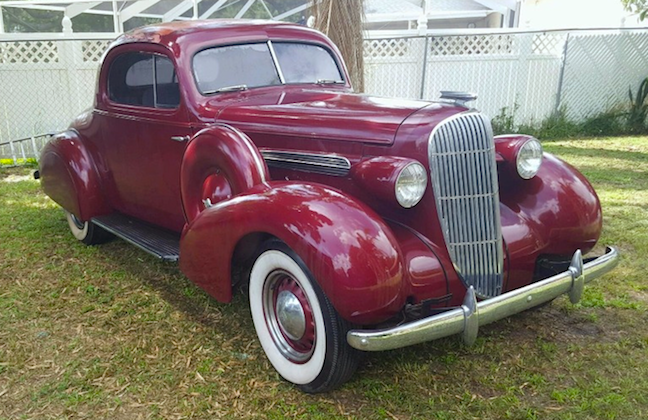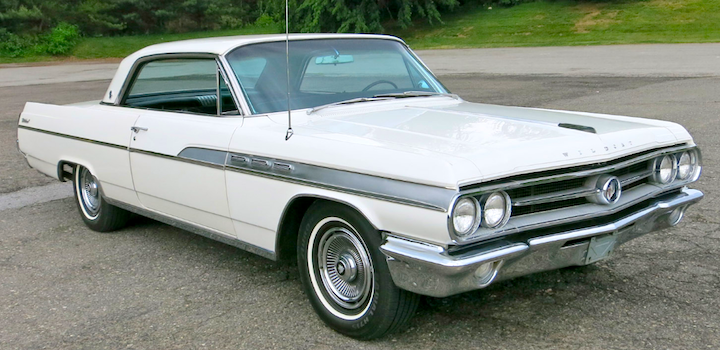But during the 35 or so years from the end of the 1920s to the early 1960s windshield designs were an important design component subject to fashion as well as evolving function.
General Motors dominated the American (and world) automobile industry during those 35-odd years. GM didn't always innovate styles and design details, but it had the resources to quickly acquire those that it didn't develop first. For that reason, I decided to use some GM cars to illustrate how windshields changed. In the images below, I mostly used the corporation's mid-line Oldsmobile brand, but brought in some Chevrolet and Buick models where needed. Unless otherwise noted, the photos below are of cars for sale, factory publicity photos, and images from sources I cannot identify.
1929 Oldsmobile
A typical windshield arrangement at the end of the 1920s. There was flat glass mounted vertically and topped by a fixed metal sun visor.
1932 Oldsmobile
Aerodynamic considerations that greatly influenced styling as the 1930s wore on were just beginning to appear by 1932. The exterior sun visor is gone and the windshield appears to be sloped back a few degrees.
1933 Oldsmobile Eight
A little more slope was introduced for 1933 while the windshield itself remains a flat, one-piece affair.
1935 Oldsmobile Six
Oldsmobiles were redesigned for 1935, becoming much more rounded. The windshield is sloped back even more. Glass is still in the form of flat planes, but now in two pieces forming a shallow V.
1937 Oldsmobile Six
The next redesign featured yet more slope along with the two-piece glass.
1940 Oldsmobile 90
Windshields are little changed on this new GM C-body. Here the glass areas is larger and A-pillars are thinner.
1948 Oldsmobile Futuramic 98
GM's first post- World War 2 redesigns appeared for the 1948 model year on Oldsmobiles and Cadillacs. The windshield remains split, but the glass is now curved thanks to improved glass-forming technology.
1950 Oldsmobile 98
The new 1950 C-bodies received curved, one-piece windshields. Other GM models retained the two-piece curved arrangement.
1951 Oldsmobile Super 88
For 1951, B-body cars got one-piece windshields with a slightly different curve profile than their C-body cousins.
1954 Buick Special
For 1954, GM's B- and C-bodies featured futuristic wraparound (panoramic) windshields, setting off a new industry-wide fashion. The B-body Buick shown here has A-pillars leaning forwards.
1954 Buick Super - Barrett-Jackson auction photo
C-body GM cars also had wraparounds, but the A-pillars were vertical.
1955 Chevrolet One-Fifty - Mecum auction photo
The following model year saw redesigned A-body cars with vertical A-pillars.
1957 Oldsmobile Super 88 - Mecum photo
Oldsmobiles were re-bodied for 1957. Panoramic windshields were retained, A-pillars leaned forwards, but were thinner.
1959 Oldsmobile Dynamic 88
All General Motors cars got a crash redesign for 1959. A-pillars were now curved towards the top, giving the windshields a compound-curve feeling. Actually, there was no strong compound curving here, but '59 Chryslers did have it.
1961 Oldsmobile
For 1960, Ford dropped panoramic windshields, reverting to the traditional aft-leaning A-pillars. GM followed suit the next year. Wraparounds were criticized for having distortion, and the dog-leg front door openings made ingress and egress more difficult. Performing the Old Switcheroo routine, the 1959 A-pillar curve at the top became a curve at the pillar's bottom in 1961.
1963 Buick Wildcat
Now windshields have become conventional: one-piece, curved, with aft-leaning A-pillars.
















1 comment:
Yikes-that 1955 Chevy 150 reminds me how obviously stripped the base models of the big 3 cars were then. Only a Depression raised Cheapskate 1950's dad would choose to buy a car that announced their cheapness to the neighborhood with almost no chrome, including black rubber showing around the windshield. Maybe being a little proto gay kid made me be a little more sensitive to the issue.
I probably only know this because of once owning a very clapped out 1955 Super convertible, but the 1954 Buick Special (C body) and Super (B body) photos show how different the two bodies were. The A columns on the C are slanted forward and vertical on the B. Then notice the air intake intruding into the base of the B windshield but not on the C. Then notice the lower fender line on the Super. The headlight surrounds look the same but at different heights. On the 1955's they are different. Yet the body touch points (?) have to be the same since the dashboards etc. are identical.
Almost the same deal with the 1957 body, but by 1959 GM realized they were making a lot of trouble for themselves and everything from a Chevy to a Cadillac had a lot more in common.
Post a Comment